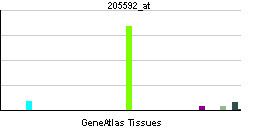Species Human Entrez 6521 | Human Mouse Ensembl ENSG00000004939 | |
 | ||
Aliases SLC4A1, solute carrier family 4 (anion exchanger), member 1 (Diego blood group), AE1, BND3, CD233, DI, EMPB3, EPB3, FR, RTA1A, SW, WD, WD1, WR, CHC, SAO, SPH4, solute carrier family 4 member 1 (Diego blood group) External IDs OMIM: 109270 MGI: 109393 HomoloGene: 133556 GeneCards: SLC4A1 | ||
Band 3 anion transport protein, also known as anion exchanger 1 (AE1) or band 3 or solute carrier family 4 member 1 (SLC4A1), is a protein that is encoded by the SLC4A1 gene in humans.
Contents
Band 3 anion transport protein is a phylogenetically-preserved transport protein responsible for mediating the exchange of chloride (Cl−) with bicarbonate (HCO3−) across plasma membranes. Functionally similar members of the AE clade are AE2 and AE3.
Function
Band 3 is present in the basolateral face of the α-intercalated cells of the collecting ducts of the nephron, which are the main acid-secreting cells of the kidney. They generate hydrogen ions and bicarbonate ions from carbon dioxide and water - a reaction catalysed by carbonic anhydrase. The hydrogen ions are pumped into the collecting duct tubule by vacuolar H+ ATPase, the apical proton pump, which thus excretes acid into the urine. kAE1 exchanges bicarbonate for chloride on the basolateral surface, essentially returning bicarbonate to the blood. Here it performs two functions:
Distribution
It is ubiquitous throughout the vertebrates. In mammals, it is present in two specific sites:
Gene products
The erythrocyte and kidney forms are different isoforms of the same protein.
The erythrocyte isoform of AE1, known as eAE1, is composed of 911 amino acids. eAE1 is an important structural component of the erythrocyte cell membrane, making up to 25% of the cell membrane surface. Each red cell contains approximately one million copies of eAE1.
The kidney isoform of AE1, known as kAE1 (which is 65 amino acids shorter than erythroid AE1) is found in the basolateral membrane of alpha-intercalated cells in the cortical collecting duct of the kidney.
Clinical significance
Mutations of kidney AE1 cause distal (type 1) renal tubular acidosis, which is an inability to acidify the urine, even if the blood is too acidic. These mutations are disease causing as they cause mistargetting of the mutant band 3 proteins so that they are retained within the cell or occasionally addressed to the wrong (i.e. apical) surface.
Mutations of erythroid AE1 affecting the extracellular domains of the molecule may cause alterations in the individual's blood group, as band 3 determines the Diego blood group.
More importantly erythroid AE1 mutations cause 15–25% of cases of Hereditary spherocytosis (a disorder associated with progressive red cell membrane loss), and also cause the hereditary conditions of Hereditary stomatocytosis and Southeast Asian Ovalocytosis
Interactions
Band 3 has been shown to interact with CA2 and CA4.
Discovery
AE1 was discovered following SDS-PAGE ( sodium dodecyl sulfate polyacrylamide gel electrophoresis ) of erythrocyte cell membrane. The large 'third' band on the electrophoresis gel represented AE1, which was thus initially termed 'Band 3'.
